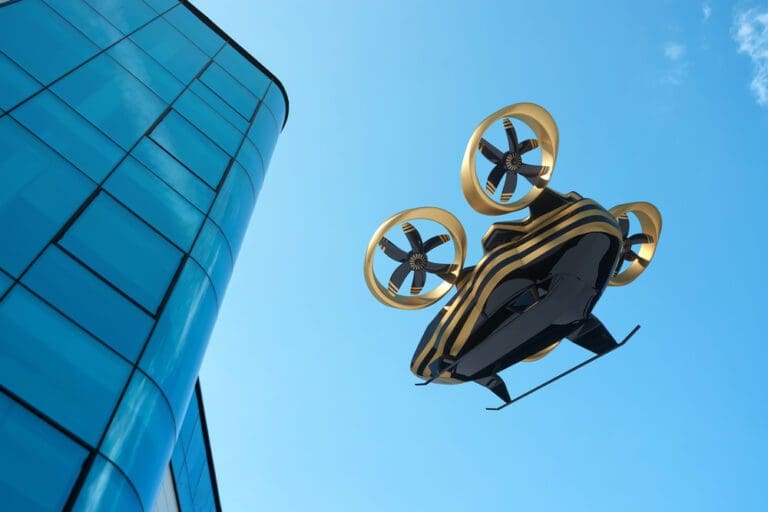Could new air travel technology revolutionise the automotive and aviation industry?
Electric flying taxi services could be operating by late 2023.
Freed from the ghost town effect of pandemic lockdowns, the world’s cities are paralysed by traffic congestion more than ever before, at a massive cost in carbon emissions, wasted fuel, motor vehicle and human productivity, and quality of life.
Even surface public transport – buses and taxis – becomes entangled in the chaos, while deliveries and business are hamstrung by lost time and revenue.

Congestion Issues
The 2022 Global Traffic Scorecard (rating 1,000 cities across 50 countries) from mobility analytics experts at INRIX shows London to be the world’s most congested city, with drivers each averaging 156 hours annually just sitting in traffic.
Other global centres are not far behind in this dubious league table: Chicago is No2 with 155 hours, Paris No3 with 138, Boston No4 with 134 and New York City No5 with 117.
And there is a staggering financial cost to this; INRIX estimates that congestion cost London USD5.7 billion in 2021 and, with energy costs spiralling – whether it be for electric or internal combustion vehicles (ICE) – the average driver was £1,377 out of pocket, just getting nowhere.
Introduction of Air Travel Technology
The idea of car technology enabling us to fly above such chaos has been around for decades, popularized in science fiction movies and TV shows such as the 1960s ‘Jetsons’ cartoon series, a futuristic counterpart to the Stone Age ‘Flintstones’.
And now the enabling technology for air mobility is here. Even before the 2020 pandemic, many people were looking skywards for a solution: electric flying taxis, able to land and take-off almost anywhere, with zero emissions at source and minimal noise.
The German company Volocopter claims it could be operating services above Singapore by the end of this year.

Such vehicles could literally lift congestion off overloaded city streets and, rather than having to come down to ground level, have urban air mobility and flit from one high rise structure to another within a city or neighbouring urban areas.
For as cities climb ever higher, inhabitants and workers can face long journeys from the vertiginous heights of one building down to ground level, then through traffic-choked streets, only to repeat the vertical journey inside another high-rise block.
Instead, an electric vertical take-off and landing (eVTOL pronounced ee-vee-tol) air taxi simply takes a door-to-door route. Volocopter CEO Florian Reuter said:
“We want to change the way people move about this planet. I’m not concerned about the uptake, the willingness of people to try it out whatsoever, because we see enough eagerness and interest worldwide.”
And while current air taxi demand is largely fulfilled by fossil-fuelled aircraft, Allied Market Research predicts that dramatic expansion to a USD6.63 billion global market by 2030 (26.2% CAGR) will be boosted by even stronger growth from electric craft, contributing USD3.39 billion (30.4% CAGR).
Many say the market will soar to even greater heights – Morgan Stanley believes an electric air taxi service could be a USD1.5 trillion market by 2040 – if certain technological, legislative and consumer breakthroughs happen more quickly.
For instance, lighter and more powerful battery systems could boost air taxi payloads, range, and commercial viability, and lower operating ‘down time’ while innovative design and durable modern materials like carbon fibre can save weight, improve manoeuvrability in confined situations, and handle flight stresses.
And what if the steering wheel and subsequently the weight and cost of a human driver could be taken out of the air taxi business model, through safe and reliable cruise control autonomous operation?
Ironically, solutions here may come from the transport mode that air taxis will most disrupt – ground motor vehicles.
MIT Technology Review is watching the development of so-called solid-state batteries. Lithium-ion batteries – the dominant type at present – use a liquid electrolyte while solid-state batteries replace this liquid with ceramics or other solid materials.

This can pack more energy in a smaller space, potentially saving weight and/or extending range, and be charged faster.
Innovators within the Industry
And while the jury is still out on autonomous car driving, Wisk Aero claims it has created the world’s first all-electric autonomous flying taxi, plus an operational framework to fit with other transport systems.
Its technology was backed by a USD450 million investment from Boeing in January 2022, before the US aviation giant paid an undisclosed sum in June 2023 to make Wisk a wholly owned subsidiary.
“We’re working to enable a future of aerospace that is safe, sustainable and at scale. Uncrewed operations will be fundamental to realizing that vision, and we have to exceed the current safety standards for the air transportation system,” said Boeing VP and Chief Engineer of Sustainability & Future Mobility, Brian Yutko.
Wisk believes it now simply awaits acceptance by the US Federal Aviation Authority (FAA) but that can never be a rubber-stamping exercise. Current air traffic control systems must also be increased radically to cope with a quantum leap in movements, and public acceptance and confidence could be another major issue, all potentially making this advanced technology mark time ahead of operational licensing.
Which prompted one eVTOL developer to take another route to market, by building an ultralight and easy-to-fly single-seat vehicle licensed for rural use by farmers and local commuters, before production ramps up to multi-seat craft.
RYSE Aero Technologies, based in Mason, Ohio, already has a 1,000-production run proposed for its relatively cheap USD150,000 Recon machine, with deliveries starting in late 2023.,
It has concentrated on making Recon legal and safe for non-trained pilots, surmising that full pilot training could also deter adoption of larger eVTOL craft. RYSE says users can be safely airborne after just 45 minutes of training.
At the other extreme is Wisk Aero’s commitment to the pilotless approach. Its four-seat Wisk 6Gen aircraft uses proven autopilot technology used on conventional commercial flights, plus improved detection, and sensors.
But maybe demand won’t wait for autonomy? Along with Volocopter’s plans for Singapore for this year, Dubai-based Falcon Aviation Services has ordered 35 EVE eVTOL air taxis from Brazilian manufacturer Embraer, to start services in 2026.
Like most electric passenger aircraft being developed, EVE resembles rotor-driven drones now common in everything from leisure to military use in war zones like Ukraine, and likely to play their own part in reducing congestion by taking many urban delivery vehicles off the road.
But this relatively conventional approach could face competition from London-based startup, Bellwether Industries, which is testing its Volar eVTOL prototype in Dubai.
The compact futuristic-looking Volar craft, looks quite different to most electric air taxi and drone designs currently being developed; a sleek ‘lifting body’ conceals the propulsion system and Bellwether is also keen to integrate with other urban transit systems on the surface and underground as well as high-level point-to-point travel.
But innovative newcomers like the Volar face some big-hitting rivals like the Korean car giant, Hyundai, which has showcased a fully electric Personal Air Vehicle (PAV) called the S-A1, able to carry four passengers and a pilot up to 100km/62 miles.
Nevertheless, there is no shortage of investment in air taxi newcomers such as California-based Joby Aviation, the UK’s Vertical Aerospace, and Germany’s Lilium.
Joby Aviation has raised over USD800 million in funding and is currently conducting test flights of its four-passenger plus pilot electric air taxi, with a 150 miles/241 kms range.
It has attracted a USD131 million US Air Force contract, worked on allied projects with America’s NASA (National Aeronautics and Space Administration) and secured investment plus a long-term supply agreement with Toyota – one of the world’s biggest motor manufacturers.
Vertical Aerospace, based in Bristol, UK, has raised over USD100 million in funding and is test flying its luxurious-looking VX4 four-seat electric air taxi, able to fly at up to 200mph, with a range of over 100 miles (161 kms).
The company wants to:
“Provide faster, quieter, greener, and smarter ways for people to travel around cities and regions.”
Lilium has raised over USD375 million in funding and is flight testing its innovative ‘electric jet’, which uses electric power to compress and exhaust propulsive air from the aircraft’s motors. It can carry seven passengers or freight up to 186 miles/300 kms.
Company Co-founder and CEO, Daniel Wiegand, said:
“Similar to what we have with cars today, we think this will be a standard means of transportation for our whole society.
“And it will become as normal for us in the 2030-, 2040- and 2045-time frame to use an eVTOL as we’re using cars today.”
Analysts at McKinsey, the global professional services giant, offer a more objective overview but confirm that “Flying taxis will happen; it’s a question of ‘when,’ not ‘if’.” McKinsey’s Robin Riedel said: “We will have aircraft that are much smaller than today’s aircraft, and they will be much more accessible. They’re going to land in your neighbourhoods. You might take a short car
ride or a ‘micromobility’ scooter ride to get to the ‘vertiport’, and you’ll go through there just like you do at a taxi stand today. You’ll get on an aircraft that will take you quite rapidly across the city or to the next city or anywhere within a 100-150-mile radius.”
Colleague Kersten Heineke added:
“And this all will be one seamless experience. I imagine it to be fully integrated into my mobility app: my e-scooter ride to the office in the morning, the trip to the airport, the flight, the trip from the airport into the city, and then, again, the scooter for the last mile. It may even be one integrated ticket. All these new vehicles are going to be fully electric; they’re going to be much cleaner and completely emission-free.”
Another colleague, Benedikt Kloss, offered a quite logical answer to any safety qualms:
“I would say that flying above the street is much safer than driving with other people on the road.”
But Robin Riedel warned that autonomous flying taxis may be further away:
“Are we going to be happy flying in an aircraft without a pilot? If something goes wrong, who do we hold accountable? And how do we certify a system as ‘good enough’? Those are important questions that a number of working groups are working on, but that will slow us down in getting to fully autonomous aircraft.”
Looking at the potential market, McKinsey reports that passengers currently spend more than USD400 billion globally on taxi services every year, with E-hailing such as Uber adding USD100 billion; by capturing just some of that market the new electric air taxi sector could be worth several billion US dollars.
Conclusion
Futuristic though it might seem, the enabling technology for electric flying taxis is here and encouraged by a market potential worth billions of dollars, a fact not lost on far-sighted smaller investors and major corporations.
Public confidence, air traffic control, vehicle range and operational ‘down time’ and whether automated driving operation is feasible or desirable, may slow its progress, but are unlikely to stop this exciting and transformative new transportation options.
As McKinsey says: “It’s a question of ‘when,’ not ‘if’.”
Companies to Watch
Wisk Aero, RYSE Aero Technologies, Joby Aviation, Vertical Aerospace, Lilium, Volocopter, Falcon Aviation Services, and Bellwether Industries.








